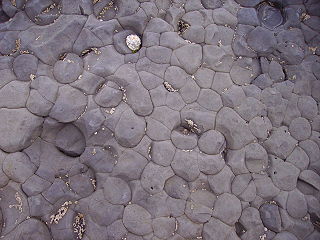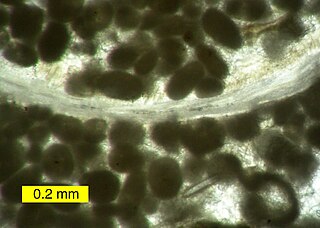Related Research Articles

Limestone is a type of carbonate sedimentary rock which is the main source of the material lime. It is composed mostly of the minerals calcite and aragonite, which are different crystal forms of CaCO3. Limestone forms when these minerals precipitate out of water containing dissolved calcium. This can take place through both biological and nonbiological processes, though biological processes, such as the accumulation of corals and shells in the sea, have likely been more important for the last 540 million years. Limestone often contains fossils which provide scientists with information on ancient environments and on the evolution of life.

Sandstone is a clastic sedimentary rock composed mainly of sand-sized silicate grains, cemented together by another mineral. Sandstones comprise about 20–25% of all sedimentary rocks.

Shale is a fine-grained, clastic sedimentary rock formed from mud that is a mix of flakes of clay minerals (hydrous aluminium phyllosilicates, e.g. kaolin, Al2Si2O5(OH)4) and tiny fragments (silt-sized particles) of other minerals, especially quartz and calcite. Shale is characterized by its tendency to split into thin layers (laminae) less than one centimeter in thickness. This property is called fissility. Shale is the most common sedimentary rock.

Sedimentary rocks are types of rock that are formed by the accumulation or deposition of mineral or organic particles at Earth's surface, followed by cementation. Sedimentation is the collective name for processes that cause these particles to settle in place. The particles that form a sedimentary rock are called sediment, and may be composed of geological detritus (minerals) or biological detritus. The geological detritus originated from weathering and erosion of existing rocks, or from the solidification of molten lava blobs erupted by volcanoes. The geological detritus is transported to the place of deposition by water, wind, ice or mass movement, which are called agents of denudation. Biological detritus was formed by bodies and parts of dead aquatic organisms, as well as their fecal mass, suspended in water and slowly piling up on the floor of water bodies. Sedimentation may also occur as dissolved minerals precipitate from water solution.
Sedimentology encompasses the study of modern sediments such as sand, silt, and clay, and the processes that result in their formation, transport, deposition and diagenesis. Sedimentologists apply their understanding of modern processes to interpret geologic history through observations of sedimentary rocks and sedimentary structures.

Conglomerate is a clastic sedimentary rock that is composed of a substantial fraction of rounded to subangular gravel-size clasts. A conglomerate typically contains a matrix of finer-grained sediments, such as sand, silt, or clay, which fills the interstices between the clasts. The clasts and matrix are typically cemented by calcium carbonate, iron oxide, silica, or hardened clay.

Mudstone, a type of mudrock, is a fine-grained sedimentary rock whose original constituents were clays or muds. Mudstone is distinguished from shale by its lack of fissility.

Mudrocks are a class of fine-grained siliciclastic sedimentary rocks. The varying types of mudrocks include siltstone, claystone, mudstone and shale. Most of the particles of which the stone is composed are less than 1⁄16 mm and are too small to study readily in the field. At first sight, the rock types appear quite similar; however, there are important differences in composition and nomenclature.

Allochem is a term introduced by Folk to describe the recognisable "grains" in carbonate rocks. Any fragment from around 0.5 mm upwards in size may be considered an allochem. Examples would include ooids, peloids, oncolites, pellets, fossil or pre-existing carbonate fragments. Fragments are still termed allochems if they have undergone chemical transformations – for example if an aragonite shell were to dissolve and be later replaced by calcite, the replacement would still be deemed an allochem.

Clastic rocks are composed of fragments, or clasts, of pre-existing minerals and rock. A clast is a fragment of geological detritus, chunks, and smaller grains of rock broken off other rocks by physical weathering. Geologists use the term clastic to refer to sedimentary rocks and particles in sediment transport, whether in suspension or as bed load, and in sediment deposits.

Calcarenite is a type of limestone that is composed predominantly, more than 50 percent, of detrital (transported) sand-size, carbonate grains. The grains consist of sand-size grains of either corals, shells, ooids, intraclasts, pellets, fragments of older limestones and dolomites, other carbonate grains, or some combination of these. Calcarenite is the carbonate equivalent of a sandstone. The term calcarenite was originally proposed in 1903 by Grabau as a part of his calcilutite, calcarenite and calcirudite carbonate classification system based upon the size of the detrital grains composing a limestone. Calcarenites can accumulate in a wide variety of marine and non-marine environments. They can consist of grains of carbonate that have accumulated either as coastal sand dunes (eolianites), beaches, offshore bars and shoals, turbidites, or other depositional settings.

Under the Dunham classification system of limestones, a wackestone is defined as a mud-supported carbonate rock that contains greater than 10% grains. Most recently, this definition has been clarified as a carbonate-dominated rock in which the carbonate mud component supports a fabric comprising 10% or more very fine-sand grade or larger grains but where less than 10% of the rock is formed of grains larger than sand grade .
Lutite is old terminology, which is not widely used, by Earth scientists in field descriptions for fine-grained, sedimentary rocks, which are composed of silt-size sediment, clay-size sediment, or a mixture of both. When mixed with water lutites often disintegrate into mud. Because this is a field term, there is a lack of any precise definition for it based upon specific grain-size characteristics. Lutites include a variety of fine-grained sedimentary rocks, including calcisiltite, calcilutite, claystone, mudstone, shale, and siltstone. It is equivalent to the term mudstone and the Greek-derived term pelite. Lutite was first used in 1904 by Grabau, who derived it from lutum, the Latin word for mud. He also proposed a number of prefixes to be used with and attached to "lutite" in order to designate various types of lutites. None of these prefixes are used by Earth scientists nowadays.
Rudite is a general name used for a sedimentary rock composed of rounded or angular detrital grains, i.e. granules, pebbles, cobbles, and boulders, which are coarser than sand in size. Rudites include sedimentary rocks composed of both siliciclastic, i.e. conglomerate and breccia, and carbonate grains, i.e. calcirudite and rudstone. This term is equivalent to the Greek-derived term, psephite. Rudite was initially proposed by Grabau as "rudyte". It is derived from the Latin word rudus for "crushed stone", "rubbish", "debris", and "rubble".

The Haynesville Shale is an informal, popular name for a Jurassic Period rock formation that underlies large parts of southwestern Arkansas, northwest Louisiana, and East Texas. It lies at depths of 10,500 to 13,000 feet below the land’s surface. It is part of a large rock formation which is known by geologists as the Haynesville Formation. The Haynesville Shale underlies an area of about 9,000 square miles and averages about 200 to 300 feet thick. The Haynesville Shale is overlain by sandstone of the Cotton Valley Group and underlain by limestone of the Smackover Formation.

Peloids are allochems that are composed of micrite, irrespective of size, shape, or origin. The two primary types of peloids are pellets and intraclasts. Another type of peloid is pseudo-oolith.
Calcisiltite is a type of limestone that is composed predominantly, more than 50 percent, of detrital (transported) silt-size carbonate grains. These grains consist either of the silt-size particles of ooids, fragments of fossil shells, fragments of older limestones and dolomites, intraclasts, pellets, other carbonate grains, or some combination of these. Calcisiltite is the carbonate equivalent of a siltstone. Calcisiltites can accumulate in a wide variety of coastal, lacustrine, and marine environments. It is typically the product of abrasion and bioerosion.
Calcirudite is a type of limestone that is composed predominantly, more than 50 percent, of carbonate grains that are larger in size than sand. The grains can consist of either fragments of fossils, fragments of older limestones and dolomites, other carbonate grains, or some combination of these. The term calcirudite was originally proposed in 1903 by Grabau as a part of his calcilutite, calcarenite and calcirudite classification system based upon the size of the detrital grains composing a limestone. Depending on roundness of the grains, calcirudite is the carbonate equivalent of either a breccia, in the case of predominantly angular grains, or conglomerate, in the case of predominantly rounded grains. Calcirudites can accumulate in a wide variety of coastal, lacustrine, and marine environments.

Pellets are small spherical to ovoid or rod-shaped grains that are common component of many limestones. They are typically 0.03 to 0.3 mm long and composed of carbonate mud (micrite). Their most common size is 0.04 to 0.08 mm. Pellets typically lack any internal structure and are remarkably uniform in size and shape in any single limestone sample. They consist either of aggregated carbonate mud, precipitated calcium carbonate, or a mixture of both. They either are or were composed either of aragonite, calcite, or a mixture of both. Also, pellets composed of either glauconite or phosphorite are common in marine sedimentary rocks. Pellets occur in Precambrian through Phanerozoic strata. They are an important component mainly in Phanerozoic strata. The consensus among sedimentologists and petrographers is that pellets are the fecal products of invertebrate organisms because of their constant size, shape, and extra-high content of organic matter.
References
- ↑ Belt, Edward (November 1967). "Sedimentology of Carboniferous Cementstone Facies, British Isles and Eastern Canada". The Journal of Geology. 75 (6): 711–721. doi:10.1086/627295. JSTOR 30061239.
- 1 2 Grabau, A.W. (1903) Paleozoic coral reefs. Geological Society of America Bulletin. vol. 14, pp. 337-352.
- 1 2 Grabau, A.W. (1904) On the classification of sedimentary rocks. American Geologist. vol. 33, pp. 228-247.
- ↑ Neuendorf, K.K.E., J.P. Mehl, Jr., and J.A. Jackson, J.A., eds. (2005) Glossary of Geology (5th ed.). Alexandria, Virginia, American Geological Institute. 779 pp. ISBN 0-922152-76-4
- 1 2 3 Flügel, E. (2010) Microfacies of Carbonate Rocks, 2nd ed. Springer-Verlag Berlin, Germany. 976 pp. ISBN 978-3-540-22016-9
- ↑ Folk, R.L., 1962, Spectral subdivision of limestone types. . In Ham, W. E.. Classification of carbonate rocks. American Association of Petroleum Geologists Memoir. no. 1, pp. 62-84.
- ↑ Scholle, P.A., D.G. Bebout, and C.H. Moore (1983) Carbonate Depositional Environments. Memoir no. 33. Tulsa, Oklahoma, American Association of Petroleum Geologists. 708 pp. ISBN 978-0-89181-310-1